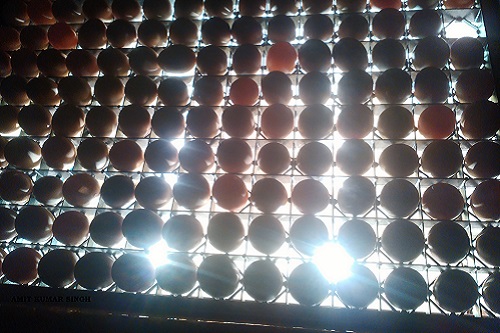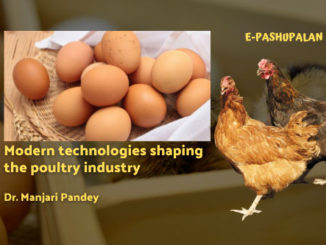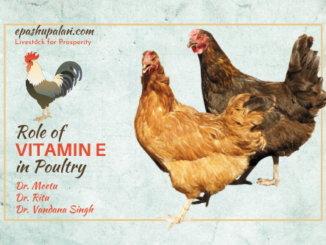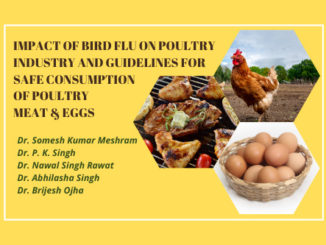Introduction
India is considered as one of the fastest growing economies of the world. Animal Husbandry sector contributes more than 25% to India’s agriculture GDP and adds directly more than 4% to India’s economy. Poultry industry may be considered as one of the fastest growing sectors in Animal husbandry sector. Poultry meat contributes more than 50% meat share under Indian meat market. People are becoming more and more health conscious and they are switching towards animal protein source such as poultry products comprising mainly chicken and eggs. As per the latest basic animal husbandry statistics of government of India, there is more than 850 million poultry birds in the country. About 534 million birds are reared under commercial system whereas rest comes from backyard poultry rearing management. Poultry sector showed a growth of 16.8% over previous livestock census in India. Availability of about 79 eggs and 2.96 kg of chicken is reported under Indian conditions which are much less than the recommendations of ICMR i.e. 180 eggs and 10.26 kg chicken per annum for individuals of India. Additionally, western nations such as USA, EU, Brazil, etc. consume chicken meat as much as more than 3 times to that of Indian situation.
There is a need to tap the growing market potential of poultry by the farmers. However, improved management facilities should be adopted for improved returns from the investment made in this venture. Hatchery operations’ efficiency may play a decisive role in determining the performance of whole flock kept of producing meat, eggs or for breeding purposes. A major issue in the hatching process of eggs is that the eggs which become infertile or suffers injuries during transport or any other defect, becomes incapable of producing chicks. This consumes unnecessary time, labour, money and infrastructure in the hatchery. Management of such eggs in early steps may help in improving the efficiency of hatchery process. Hence, candling process is applied during specific periods in hatchery for monitoring the hatching of eggs.
Hatchability of fertile broiler eggs is around 60% to 90% in most of the cases. Hatchery consists of basically two parts namely- Incubator for 18 days and Hatcher for 18th to 21st day. There are several operations done in between those two parts. Candling of eggs is one of those most important aspects of Hatchery. Generally candling is done on 6- 8th day of incubation operation when a considerable angiogenesis has been established in case of fertile eggs. Not much complex science is involved in candling, a little familiar and experienced operator can handle the candling operation well.
Candling of eggs
Basic principle involving candling is setting eggs in candling machine so that light could be passed through a point source towards particular egg. It is done in completely dark room. While light passes by, opaque and translucent images of eggs are obtained which is shown in figure below. Opaque eggs are sent further for upcoming incubation and translucent ones are withdrawn from incubation and can be sent for marketing if not broken.

Opaque eggs are found to be as hatchable whereas translucent ones are not as shown in figure (1). A little experienced person can easily handle the candling operation with satisfactory accuracy. Eggs which are supposed to be set in incubation chamber of hatchery should be as fresh as possible. Hatchability of fresh fertile is considerably more as compared to that in stored eggs. Color of egg shells are of quite significance as when, egg shell color is white it is much easier to do candling operation as compared to that in brown and blackish ones.
There are obvious advantages of candling of eggs
- It creates space for other eggs in incubator
- Energy could be saved from processing of unfertile and un-hatchable eggs
- Less labour time would be needed in further operations
- It helps in finding the actual hatchability of eggs
- Increases efficiency of hatchery operations
- It is helpful to avoid bacterial growth inside incubator as by candling bad eggs are culled in early stage of incubation.
Types of candling
Types of candling process may be broadly understood as small scale/home use candling and large scale/industrial candling.
Small scale/ Home use candling process are followed for less number of eggs which may be 1 to 50. Small capacity candlers are available in market for this purpose. Simple candler can be homemade by using a convergent light beam such as a flashlight or torch. On the other hand, large scale/ industrial candling involves large number of eggs which may be upto several lakhs a day. It is done by highly automated machines which are quick, more accurate but are quite costly.
Precautions during candling
- Candler should be used in completely dark room.
- Eggs should be handled gently to avoid any damage.
- Eggs should not be kept under candling for longer period of time as it may hinder growth of embryos due to excessive heating.
- Leveling of candler should be appropriate for better observation.
Utilization of small scale candler in backyard farming
Backyard poultry farmers may easily utilize this technology for determining un-hatchable eggs at early stages. They may require an opaque cylindrical container in which light sources say light emitting diode bulb costing hardly 5 Rs may be fitted in. The cylindrical container should be in such dimension that it only can hold the egg over it and do not swallow it. Based on little experience the farmers may easily perform this task.
A considerable amount of loss of money could be saved from candling of eggs. The eggs which are infertile and have been determined during early hatching process may be sold out and considerable income may be generated through it. Other dead eggs or poor eggs may be heat treated and may be used as soil fertilizer. This may help in adding to the income of the poultry farmer.
Conclusions
Candling of egg is an indispensable part of hatchery operations. It not only helps in increasing efficiency of hatchery operation by separating bad and unfertile eggs but also cuts the cost of operation. Contamination in hatchery can be prevented to a great extent with help of this method. Poultry farmers may surely get the benefits of proper candling of eggs. By following the above mentioned principles, procedures and precautions, candling operation can be readily understood and applied in hatchery operations with good efficiency.






Be the first to comment